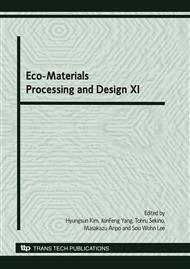p.1
p.5
p.9
p.13
p.17
p.21
p.25
p.29
Synthesis of Spherical Carbon Nanoparticles and their EDLC Properties
Abstract:
Spherical carbon nanoparticles were synthesized by sol-gel polymerization of resorcinol and formaldehyde in the presence of CTAB(cetyltrimethylammonium bromide) and subsequent carbonization at 900°C. It is found that the amount of CTAB, water and catalyst showed a significant impact on the morphology and size of carbon nanoparticles. According to the BET surface area and capacitance, the nanoparticles were divided into two groups. The carbon nanoparticles with surface area of 725-758 m2/g showed capacitance between 120-140 F/g, while those with surface area of 596-649 m2/g showed capacitance only 60-80 F/g. Difference in the pore size of 1.5 nm to 3.0 nm probably contributed to the difference of capacitance.
Info:
Periodical:
Pages:
9-12
Citation:
Online since:
July 2010
Authors:
Keywords:
Permissions:
Share:
Citation:


